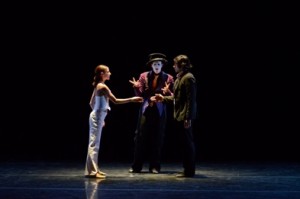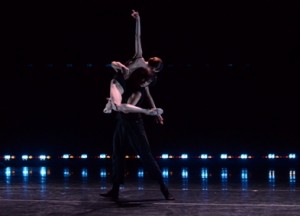JACOB’S PILLOW
3e etage (Third Floor)
Ted Shawn Theatre
August 3-7, 2011
Review by Anna Rogovoy
(BECKET, Mass.) – The concept of 3e étage’s engagement at Jacob’s Pillow, a mixed bill of works which interweave to form a single program titled “Disorders,” was well suited to the U.S. debut of a company of this unusual nature. 3e étage (Third Floor) is comprised of seven men and four women of the Paris Opera Ballet, a group noted for its rigorous training and for its annual corps de ballet exam that’s intended to encourage the continual advancement of its dancers even after they have been accepted into the company. The dancers in this ensemble are first soloists, soloists, and corps members of Paris Opera, and each one displays a sublime technical facility. But what was most pleasantly surprising was the versatility and range they achieved in this extensive, eclectic program.
The first work, La Valse Infernale, is referred to as “a devilishly difficult showpiece” meant to test the limits of the dancers’ technique. Choreographed by artistic director Samuel Murez under the name Raul Zeummes to replace what had previously been the most difficult work in 3e étage’s repertory, it shows five dancers in all their glory, making neat work of dizzyingly fast jumps and turns. The relationship between the five performers is one of playfully jousting camaraderie; the choreography often overlaps two dancers, as if one were finishing another’s sentence. It’s enjoyable to get a glimpse of how this sort of taxing work can foster closeness between dancers, as opposed to the cutthroat competition more commonly depicted as being central to the ballet world.

Ludmila Pagliero, Samuel Murez, and Takeru Coste of 3e Étage in 'Épiphénomènes' (photo Cherylynn Tsushima)
This relationship is addressed more explicitly later on in Murez’s Processes of Intricacy, which features two dancers (Ludmila Pagliero and Takeru Coste on Thursday evening) in rehearsal attire running through several sequences of complex partnering. Murez strips away the frippery and adornment often associated with performance: Pagliero and Coste do not wear the obligatory smiles that are as much a part of a costume as a tutu, and their only accompaniment is the sound of a technical rehearsal. A stage manager’s voice calls out light cues, and the stage itself is amplified so that every intake of breath or thump of landing is audible. The beautifully natural rapport between dancers combines with this elements to lend an unusual intimacy, and moments of pause and reflection render them explicitly human.
Immediately following Processes of Intricacy is an excerpt from William Forsythe’s Limb’s Theorem, which the choreographer identifies as “an analysis of the mechanics inherent to classical dance performance.” Choreographically similar to Processes, the presentation is diametrically different, the performers adopting an aloof, ethereal quality (and more formal costumes, including pointe shoes for the women) to attack Forsythe’s angular movement with elegant vigor. The contrast in approaches to presenting virtuosity is a theme of “Disorders,” one aptly explored in the pairing of these two works.
Other highlights on the program include Richard Siegal’s neoclassical For Hands, a quartet set to music by Jean-Philippe Rameau. Siegal, a former dancer with Forsythe, chose to focus on the articulation and use of hands, an unusual choice for an otherwise ballet-rooted work. Fluid arcs and lines of the body are terminated in surprising ways as the dancers cup and twist their wrists, reaching over, around, and under unseen objects. Murez’s Chaconne, a duet danced with intense clarity by Lydie Vareilhes and Alexandre Carniato, uses closely connected partnering to plumb the emotional history of a relationship. The array of characters and movement influences brought together in “Disorders” is a delicious smorgasbord, and the exquisite dancers of 3e étage tackle it with gusto and grace.
Anna Rogovoy is chief dance for The Rogovoy Report. She studies dance, literature and writing at Bennington College.

